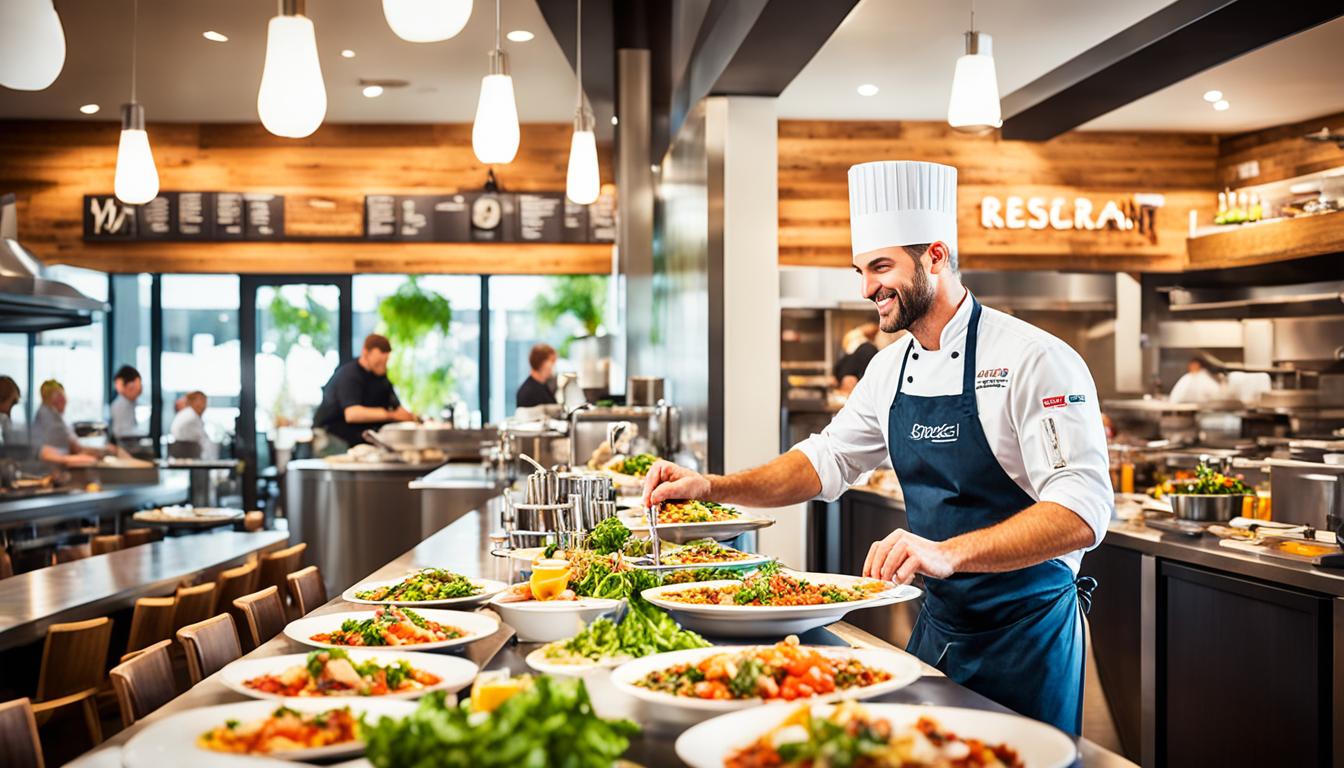Welcome to our essential guide on how to startup a restaurant! If you’ve always dreamt of opening a dining establishment and sharing your passion for food with others, you’re in the right place. This comprehensive guide will take you through the essential steps to turn your restaurant vision into a reality.
Starting a restaurant is not just about serving delicious meals. It requires a combination of culinary expertise, business acumen, and effective marketing strategies. With our step-by-step approach, you’ll learn the key elements necessary for a successful restaurant startup.
Whether you’re interested in launching a bistro, setting up a food venue, or opening a dining establishment, we’ve got you covered. Our guide encompasses valuable tips and strategies that can help you achieve your goal of becoming a successful restaurateur.
Throughout this guide, we’ll delve into important topics such as choosing the right restaurant type that aligns with your vision, developing a comprehensive business plan, selecting the perfect location, crafting an irresistible menu, understanding the costs involved, and more.
So, are you ready to embark on a culinary adventure? Let’s dive right in and discover the key ingredients for a successful restaurant startup!
Choose the Right Restaurant Type for Your Vision
When starting a restaurant, it’s essential to choose a concept that aligns with your entrepreneurial spirit. The type of restaurant you select will determine the atmosphere, menu, and target audience. Consider factors such as the type of service you want to provide. Do you envision a fast-casual eatery, a fine dining establishment, or a vibrant café? This decision will shape the overall dining experience and set the tone for your business.
Another critical consideration is your target audience. Identifying your ideal customer base will help you tailor your restaurant’s offerings and marketing strategies. Are you targeting families, young professionals, college students, or a specific niche? Understanding your target demographic will guide your menu development and help you create an inviting ambiance.
Additionally, it’s important to develop a unique brand that sets your restaurant apart from the competition. Your brand should reflect your vision, values, and the experience you want to provide to your customers. Think about the overarching theme, décor, and ambiance that aligns with your concept. By creating a distinctive brand identity, you can attract loyal customers and stand out in a crowded market.
Looking for low-cost restaurant start-up ideas? Consider alternative options that provide flexibility and minimize initial investment. Food trucks, for example, can be an excellent way to enter the culinary industry without the financial burden of a brick-and-mortar location. They allow you to reach different locations, test your menu, and build a dedicated customer base. Another option is a ghost kitchen, where you can focus on delivery and takeout services, eliminating the need for a dine-in space. Home-based catering businesses are also gaining popularity, leveraging the rising demand for personalized dining experiences.
By carefully considering the service type, target audience, and unique brand, you can select the right restaurant type that aligns with your vision and budget. Whether you opt for a traditional dine-in establishment or explore innovative alternatives, it’s crucial to focus on delivering exceptional dining experiences that keep customers coming back for more.
Develop a Comprehensive Business Plan
A well-crafted business plan is crucial for starting a restaurant. It serves as a roadmap that guides your entrepreneurial journey, ensuring you have a clear direction from the outset. A comprehensive business plan outlines essential components that contribute to the success of your restaurant venture.
Key Components of a Business Plan
- Restaurant Name and Concept
- Target Market Analysis
- Model Type and Service Style
- Staffing and Customer Service Policies
- Financial Projections
Start by carefully brainstorming a unique and memorable restaurant name that resonates with your brand. Consider conducting thorough market research to identify your target audience and analyze their preferences and dining habits. This information will guide your decision on the type of restaurant model and service style that will appeal to your intended customers.
Furthermore, staffing and customer service policies are crucial components that define the culture and atmosphere of your dining establishment. Outline your staffing requirements, including staff roles and responsibilities, training programs, and a customer service strategy that ensures an exceptional dining experience for your guests.
To ensure the financial viability of your business, include a detailed financial projection that outlines your revenue streams, anticipated expenses, and profitability forecasts. This will help you gauge the feasibility of your restaurant venture and develop a solid financial strategy.
Devising an Effective Marketing Plan
In addition to the essential components of a business plan, you must also devise a comprehensive marketing plan to promote your restaurant and attract customers. In today’s digital age, traditional marketing strategies alone are not sufficient. Embrace the power of digital platforms and develop a robust online presence to reach a wider audience.
Consider incorporating the following marketing strategies into your plan:
- Social Media Marketing: Utilize popular platforms such as Facebook, Instagram, and Twitter to engage with your target audience, share enticing food visuals, promote special offers, and communicate updates.
- Branding: Develop a strong, consistent brand identity that reflects the unique personality and values of your restaurant. This includes a compelling logo, visually appealing menus, and cohesive design elements across all marketing materials.
- Email Marketing: Build a database of customer contacts and implement email marketing campaigns to stay connected with your audience. Send regular newsletters, exclusive promotions, and updates to maintain customer loyalty.
- Search Engine Optimization (SEO): Optimize your website content and online listings with relevant keywords and metadata to improve your restaurant’s visibility on search engines like Google.
By devising an effective marketing plan that combines both traditional and digital strategies, you can create awareness, build a loyal customer base, and establish a competitive edge within the restaurant industry.

Implementing a well-thought-out business and marketing plan is essential for the success of your restaurant. It provides clarity, direction, and a roadmap to navigate the challenges of the industry. By carefully considering the essential components outlined above and leveraging effective marketing strategies, you can increase your chances of creating a profitable and thriving culinary business.
Choose the Perfect Location for Your Restaurant
When it comes to starting a restaurant, selecting the right location is crucial for its success. The perfect location can attract the target audience and create a positive atmosphere that aligns with the type of food being served. As a restaurateur, it’s essential to consider several factors to ensure you choose a prime location.
Factors to Consider
1. Sizing and Capacity: Assess the size of the space and its capacity to accommodate your restaurant concept. Determine if it can comfortably house the required number of seats, kitchen equipment, and storage areas.
2. Neighborhood Community: Research the neighborhood where you plan to establish your restaurant. Look for an area with a vibrant community and a strong consumer base that matches your target audience. Consider factors such as demographics, income levels, and local preferences for cuisine.
3. Building History: The history and reputation of the building can significantly impact your restaurant’s image. A well-known and respected building can lend credibility and attract customers. However, be aware of any potential negative associations or challenges that might arise from the building’s past.
Important Considerations
When evaluating potential locations, keep these essential location factors in mind:
Remember, the success of your restaurant not only depends on the food and service but also on the accessibility and ambiance offered by the location.
- Accessible: Choose a location that is easily accessible by public transportation and has ample parking facilities. This makes it convenient for customers to visit your restaurant.
- Competition: Assess the level of competition in the area. Too many similar restaurants in close proximity may pose a challenge. On the other hand, being in an area with complementary establishments can attract a diverse customer base.
- Foot Traffic: Consider the amount of foot traffic the location attracts. High foot traffic areas can increase visibility and exposure for your restaurant, potentially leading to more walk-in customers.
- Zoning Restrictions: Understand the zoning regulations and restrictions for the area. Ensure the location is zoned for restaurant use and complies with local health and safety regulations.
- Cost and Lease Terms: Analyze the cost of the location, including rent, utilities, and other expenses. Negotiate favorable lease terms to avoid unnecessary financial strain.
By carefully evaluating these factors and conducting thorough research, you can choose a prime location for your restaurant that sets the foundation for long-term success.

| Pros | Cons |
|---|---|
| 1. High visibility and increased foot traffic | 1. Higher rent or lease costs |
| 2. Access to a strong customer base | 2. Potential competition from nearby restaurants |
| 3. Positive reputation associated with historic buildings | 3. Potential challenges with building maintenance or renovations |
| 4. Opportunity to create a unique ambiance | 4. Limited availability of prime locations |
Craft an Irresistible Menu
The menu is a crucial element of a restaurant. It serves as a reflection of your culinary identity, enticing customers with a delectable array of dishes. To create an irresistible menu, it is important to map out your menu thoughtfully, considering the preferences of your target audience and incorporating high-quality, seasonal ingredients.
When designing your menu, keep in mind the menu pricing factors to consider. Consider the costs associated with the dishes you offer, including ingredients, preparation time, and portion sizes. By carefully calculating these factors, you can determine the ideal pricing that not only covers your expenses but also remains competitive with other establishments.
Here are some menu pricing factors to consider:
- Cost of Goods Sold (COGS): Calculate the total cost of ingredients and supplies used to prepare each dish. This will help you determine a baseline price for your menu items.
- Food Cost Percentage: Determine the food cost percentage by dividing the cost of ingredients by the selling price of the dish. Aim for a food cost percentage of around 30-35% to ensure profitability.
- Profit Margins: Set profit margins for each menu item by considering factors such as labor costs, overhead expenses, and desired profitability. Balancing these margins is crucial to sustain your business.
- Sales Forecasting: Analyze past sales data and make informed projections for future sales. This will help you estimate the volume of each dish that you can sell and adjust your pricing accordingly.
- Inventory Management: Efficiently manage your inventory by regularly monitoring ingredient usage and adjusting your menu based on ingredient availability. This will prevent wastage and optimize your costs.
Remember, menu pricing factors to consider extend beyond cost and profit. It’s important to consider your target audience, their dining preferences, and the perceived value of your offerings. Keep an eye on your competitors’ pricing to ensure your menu remains competitive in the market.
A well-crafted menu not only entices customers but also sets the tone for their dining experience. A visually appealing and organized menu layout can guide your customers through your offerings and make their ordering process effortless. Additionally, consider incorporating specials of the day or seasonal dishes to keep your menu fresh and create a sense of excitement among your customers.
By carefully mapping out your menu and considering the menu pricing factors to consider, you can ensure a delightful dining experience for your customers while maintaining financial success for your restaurant.

Understand the Costs of Starting a Restaurant
Starting a restaurant involves various expenses that aspiring restaurateurs need to consider. From remodeling or making improvements to the premises to purchasing essential equipment, furniture, and supplies, it’s essential to carefully budget and account for these costs to ensure the financial sustainability of your restaurant.
Remodeling or Restaurant Improvements
If you’re starting a new restaurant or taking over an existing space, remodeling or making improvements may be necessary to create a welcoming ambiance and ensure the efficient flow of operations. This can include renovating the dining area, kitchen, restroom facilities, and exterior, as well as addressing any structural, plumbing, or electrical issues that may exist. The costs associated will largely depend on the scale and complexity of the project, as well as the location of your restaurant.
Restaurant Equipment
Investing in high-quality, reliable restaurant equipment is crucial to the success of your business. From commercial-grade ovens and grills to refrigerators, freezers, and dishwashers, having the right equipment will enhance efficiency and productivity in the kitchen. It’s important to research different brands and suppliers to find equipment that meets your specific needs and budget. Remember to consider the durability and maintenance requirements of the equipment to ensure long-term cost-effectiveness.
Restaurant Furniture
The furniture you choose for your restaurant will impact the overall dining experience of your customers. From tables and chairs to booths and bar stools, you’ll need to invest in comfortable and aesthetically pleasing furniture that complements your restaurant’s theme and atmosphere. Keep in mind that quality furniture can withstand regular use and require less frequent replacement, saving you money in the long run.
Supplies and Technology
Operating a restaurant requires a constant supply of various items, such as cutlery, crockery, glassware, napkins, cleaning supplies, and cooking ingredients. It’s essential to accurately estimate your monthly usage and budget for these ongoing expenses. Additionally, advances in technology can significantly enhance your restaurant’s efficiency, customer service, and marketing efforts. Consider investing in point-of-sale systems, reservation management software, online ordering platforms, and social media management tools to streamline operations and drive revenue.
By carefully planning and budgeting for these costs, you can set your restaurant up for success from the start. Remember to take into account the unique needs of your establishment and seek advice from industry professionals to ensure you have a comprehensive understanding of the potential expenses you may face.
Conclusion
Starting a restaurant business is an exciting venture that requires careful planning, dedication, and a solid strategy. By following the steps outlined in this comprehensive restaurant start-up guide, aspiring restaurateurs can increase their chances of success in the competitive culinary industry.
From choosing the right restaurant type and location to developing a comprehensive business plan, crafting an irresistible menu, understanding the costs involved, and implementing effective marketing strategies, every aspect requires careful consideration.
Remember, the key to a thriving restaurant business lies in staying focused, adapting to market trends, and providing exceptional dining experiences. By continuously evaluating and refining your restaurant launch strategy, you can attract and retain loyal customers, establishing a strong foothold in the industry.
FAQ
What type of restaurant should I choose?
When starting a restaurant, it’s essential to choose a concept that aligns with your entrepreneurial spirit. Consider factors such as the type of service, target audience, and unique brand. If budget is a concern, low-cost start-up ideas like a food truck, ghost kitchen, or home-based catering business can be considered.
What should I consider when choosing a location?
The location of a restaurant plays a significant role in its success. Factors to consider include sizing and capacity, the neighborhood community, and the history of the building. The ideal location should attract the target audience and align with the type of food being served.
How can I increase my chances of success in the restaurant business?
Opening a restaurant requires careful planning, budgeting, and strategic decision-making. By following the steps outlined in this guide, aspiring restaurateurs can increase their chances of success and build a thriving culinary business. Remember to stay focused, adapt to market trends, and provide exceptional dining experiences to attract and retain customers.




